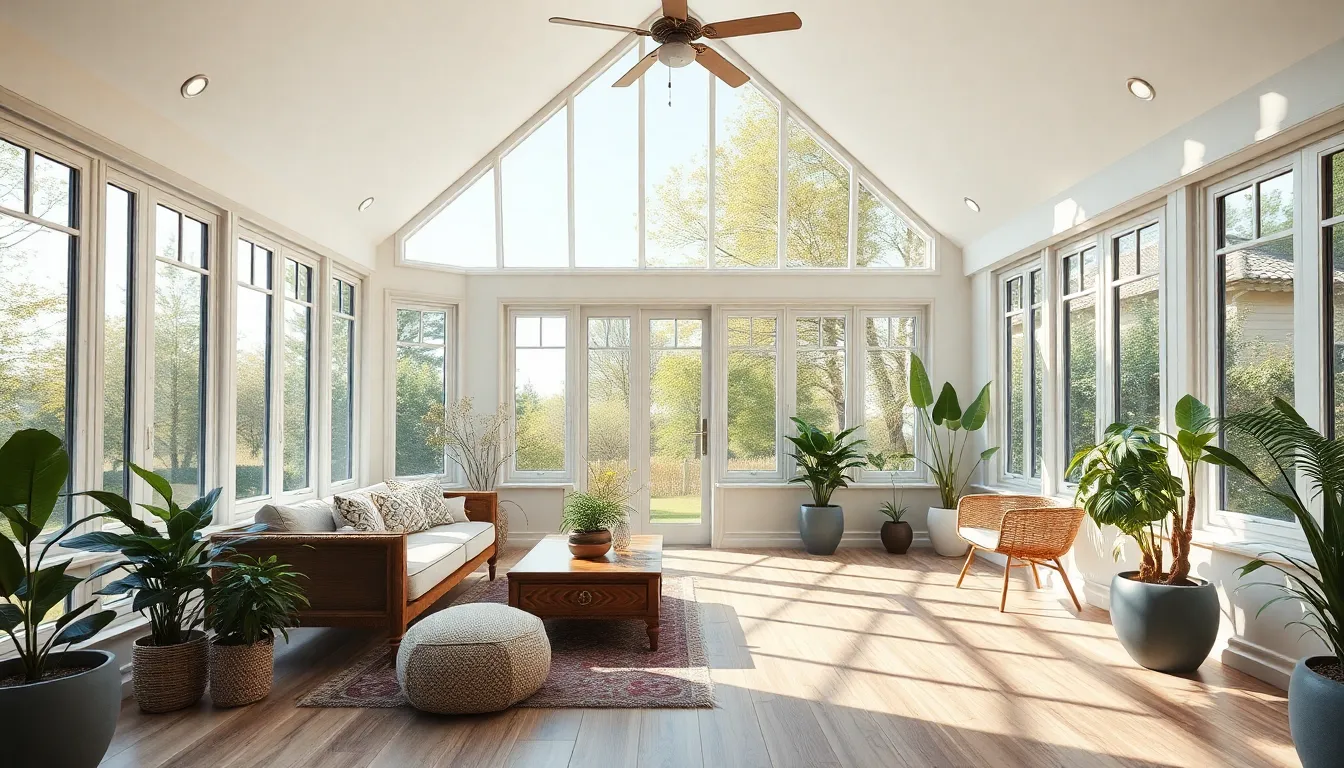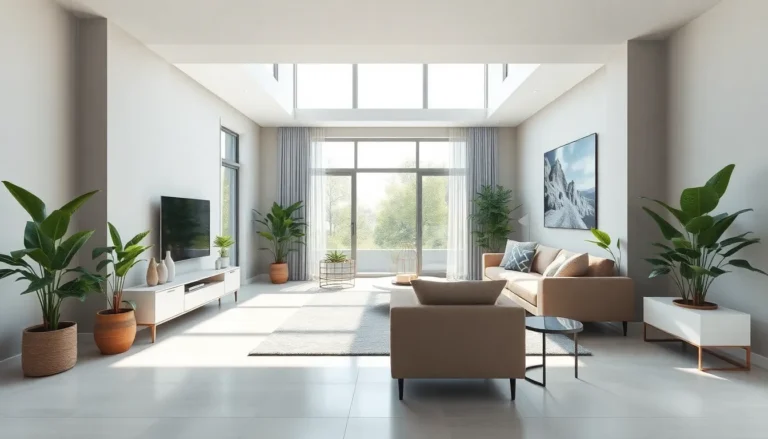Table of Contents
ToggleA sunroom can transform a home into a bright and inviting space, blending the comforts of indoors with the beauty of the outdoors. With the right design, it becomes a perfect retreat for relaxation, entertaining, or enjoying a morning coffee while soaking in the sunlight.
Choosing the right elements for a sunroom is crucial for creating a harmonious atmosphere. From selecting the ideal furniture to incorporating plants that thrive in bright conditions, thoughtful design choices can enhance the overall experience. This article offers essential tips to help anyone create a stunning sunroom that reflects their personal style and maximizes natural light.
Choosing the Right Location
Selecting the ideal location for a sunroom significantly impacts its function and aesthetic appeal. A well-placed sunroom maximizes natural light and enhances the overall home environment.
Factors to Consider
Consider proximity to existing rooms, accessibility to utilities, and any zoning regulations. Placement near living spaces, such as the living room or kitchen, promotes better flow and convenience. Ensure alignment with local building codes, which can vary by region and determine the feasibility of construction.
Sun Exposure and Views
Evaluate sun exposure throughout the day and potential views from the sunroom. South-facing orientations capture maximum sunlight, ideal for growing plants and enjoying warmth during colder months. North-facing locations provide indirect light, suitable for those desiring a cooler space. Assess surrounding landscapes for scenic views, which can enhance relaxation and enjoyment within the sunroom.
Selecting Materials

Selecting the right materials is crucial for creating an inviting and functional sunroom. The material choices significantly impact aesthetic appeal, durability, and overall comfort.
Windows and Glass Options
Choosing windows and glass types involves considering insulation, energy efficiency, and aesthetics.
- Double-Glazed Glass: This option offers superior insulation, reducing heating and cooling costs while enhancing comfort in varying seasons.
- Low-E Glass: Coated with a reflective layer, low-emissivity glass minimizes UV rays’ penetration, protecting furniture and flooring from fading.
- Tempered Glass: This option provides durability and safety, as it shatters into small pieces rather than sharp shards, making it ideal for sunroom usage.
- Vinyl Frames: Known for their low maintenance and energy efficiency, vinyl frames can withstand harsh weather while complementing diverse design styles.
Flooring Choices
Selecting the right flooring enhances the sunroom’s functionality and aesthetics.
- Tile Flooring: Offering water resistance and durability, tile flooring is easy to clean and ideal for areas with high moisture levels.
- Composite Decking: This material provides UV resistance and requires minimal maintenance while delivering the look of wood without the drawbacks.
- Luxury Vinyl Plank: This versatile option mimics the appearance of hardwood or stone while resisting scratches and providing comfort underfoot.
- Natural Stone: Providing a unique and upscale look, natural stone offers durability, though it may require sealing to prevent staining and damage.
Color Schemes and Aesthetics
Choosing the right color schemes and aesthetics can significantly enhance the overall appeal of a sunroom. Color influences mood and light perception, making thoughtful selections essential for a harmonious design.
Popular Color Palettes
- Neutral Tones: Light grays, beiges, and whites create a calm atmosphere, allowing natural light to prevail. These colors make the sunroom feel spacious and inviting.
- Earthy Shades: Greens, browns, and soft yellows evoke nature, complementing the outdoor views and creating a serene environment. These hues work well with plant integration.
- Bold Accents: Bright blues, oranges, or deep reds serve as eye-catching focal points. Utilizing these shades in accessories or feature walls adds vibrancy without overwhelming the space.
- Pastel Hues: Soft pinks, lavenders, and light blues promote a gentle, relaxed aesthetic. These colors are ideal for creating a serene retreat within the home.
Integrating with Home Design
- Cohesive Color Flow: Sunroom colors should align with the overall palette of the home to ensure a seamless transition between spaces. Matching hues provide a sense of unity.
- Architectural Harmony: Emphasizing architectural features, such as beams or moldings, in complementary colors highlights distinctive elements and enhances visual interest.
- Material Consideration: Selecting colors that match the sunroom’s materials, like flooring or furniture, reinforces design integrity. For instance, warm wood tones pair well with earth-inspired palettes.
- Seasonal Adaptation: While some may prefer chosen colors, flexibility in accents allows for seasonal updates, keeping the sunroom feeling fresh and welcoming year-round.
Furniture and Decor
Selecting furniture and decor enhances functionality and aesthetic appeal in a sunroom. Thoughtful choices create a warm and inviting atmosphere that complements the natural light.
Optimizing Space
Maximizing space in a sunroom involves strategically placing furniture and decor to improve flow.
- Multi-functional furniture: Use sofas with built-in storage or ottomans that serve dual purposes. These options free up floor space and maintain organization.
- Space-saving designs: Opt for sleek tables and chairs that easily tuck away when not in use. This approach creates an open area for movement and activities.
- Zoning: Create designated areas for relaxation, dining, or gardening. Use rugs or furniture arrangements to differentiate these zones, ensuring each serves a specific purpose.
Comfort and Style
Comfort and style significantly enhance the sunroom experience, providing a cozy retreat.
- Comfortable seating: Choose cushioned sofas and chairs that invite relaxation. Incorporate throw pillows and blankets to add both comfort and visual interest.
- Textiles and patterns: Select drapery and cushions in light, airy fabrics to promote a relaxed vibe. Floral patterns or natural motifs reinforce the connection to the outdoors.
- Natural elements: Introduce wood, wicker, or rattan furniture for an organic feel. These materials blend seamlessly with the surrounding environment, showcasing a harmonious design.
- Artistic accents: Incorporate wall art or sculptures that reflect personal style. A few well-placed pieces can elevate the entire space and express individuality.
Enhancing Functionality
Enhancing functionality in a sunroom involves smart heating and cooling solutions, as well as thoughtful lighting considerations. These elements ensure a comfortable environment throughout the year.
Heating and Cooling Solutions
Heating and cooling options directly impact the usability of a sunroom. Installing a programmable thermostat provides temperature control and energy efficiency. Options include:
- Radiant floor heating: Delivers consistent warmth through the floor, making the space cozy in colder months.
- Mini-split systems: Offer both heating and cooling capabilities with individual control for zones within the sunroom.
- Ceiling fans: Promote air circulation and provide a cooling effect, enhancing comfort during warm days.
- Portable heaters or fans: Serve as flexible solutions for targeted heating and cooling without major installation.
Integrating these systems optimizes year-round usability while allowing for personalized comfort.
Lighting Considerations
Proper lighting amplifies the sunroom’s ambiance and functionality. Key considerations for lighting include:
- Natural light: Maximize daylight with large windows or glass doors, enhancing the connection to the outdoors.
- Layered lighting: Utilize a mix of ambient, task, and accent lighting. This approach allows for adjustable brightness, catering to various activities.
- LED fixtures: Offer energy-efficient options, providing bright illumination with longevity and low heat emission.
- Dimmers: Enable control over brightness levels, allowing for a cozy atmosphere during evenings or gatherings.
Incorporating varied lighting solutions increases the sunroom’s versatility and appeals to its occupants throughout the day.
Designing a sunroom is an exciting opportunity to blend comfort with nature. By carefully considering elements like location materials and color schemes, homeowners can create a space that feels both inviting and functional. Thoughtful furniture choices and smart heating and cooling solutions further enhance the sunroom’s usability throughout the year.
Incorporating personal style through decor and artistic accents can transform a sunroom into a unique retreat. With the right approach, a sunroom becomes more than just an addition; it evolves into a cherished part of the home that fosters relaxation and enjoyment. Embracing these design tips will help anyone craft a stunning sunroom that truly reflects their vision.


